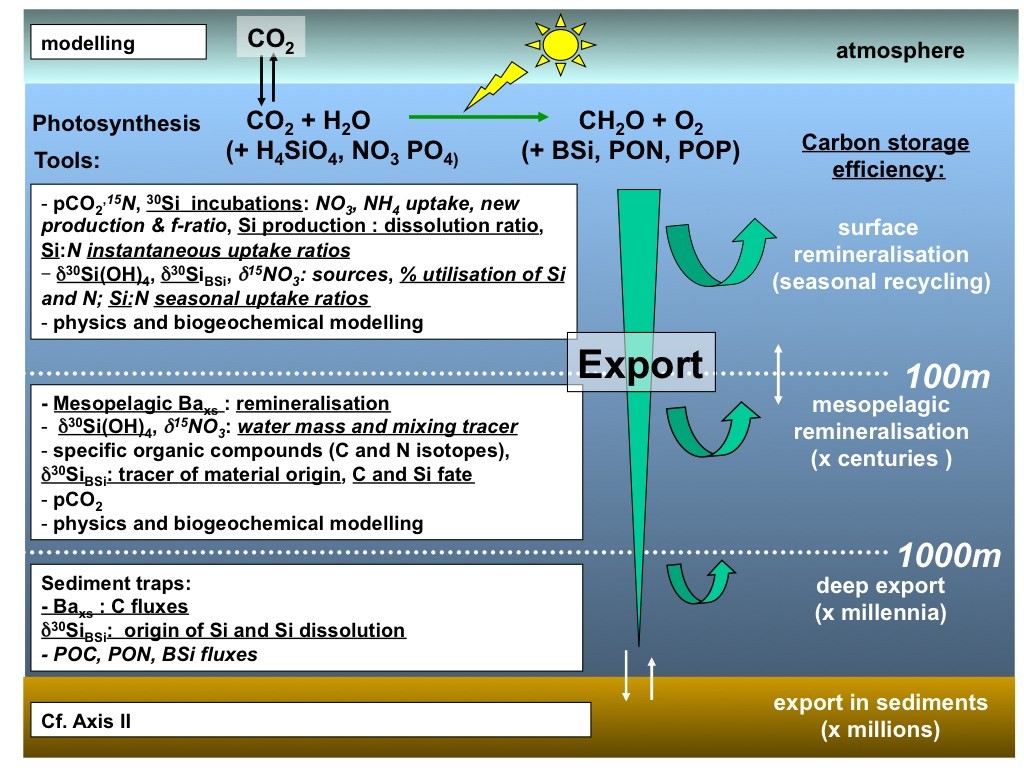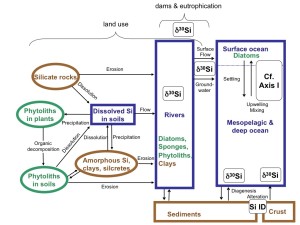MuSiCC Scientific objectives
Although decoupled in time and space in the ocean, the silicon (Si) and carbon (C) cycles are closely linked. The role played by these elements in climate and marine ecosystems is essential and their biogeochemical cycle is undergoing dramatic changes. MuSiCC, proposes to bring unique know-how, developed abroad by the scientist in charge, to Université Pierre & Marie Curie, a leading French university. MuSiCC is based on the implementation of an advanced multi-proxy approach integrating several temporal scales and processes.
Two distinct research axes are proposed.

Scheme representing MuSiCC research Axis I. The boxes represent the methods applied and the information that can be obtained from the proxies. Underlined text refers to the new proxies and information transferred to UPMC, plain text to the expertise already present at UPMC-IPSL and italics to the expertise to be carried out by international collaborators.
Axis I Silicon and carbon cycles in the Southern Ocean
The specific objectives of Axis I are to quantify for the different biogeochemical provinces of the SO, the seasonal evolution of:
- Si nutrient supply
- Diatoms’ Si production
- Organic C and silica export out of the surface layer via the biological pump
- Mesopelagic remineralisation and the ultimate export of C to the deep ocean
Axis II Si cycle at continent – ocean interfaces

Scheme representing MuSiCC research Axis II. This scheme is based on the biogeochemical cycle of Si adapted from Meunier et al. (2001). The boxes/ellipses with bold lines represent Si reservoirs at the Earth’s surface. The plain rounded boxes represent the sites where MuSiCC proxies will be applied. Shaded rounded boxes depict the thematic expertise of partners.
Axis II is structured under three specific objectives:
- What is the contribution to Si cycle of sedimentary diagenesis in the continental margins?
- What is the contribution and fate of riverine biogenic silica fluxes to the ocean?
- How do anthropogenic pressures affect the Si cycle in estuarine and coastal zones?
Methods
For the two axes, we implement a multi-proxy approach to achieve these objectives based on:
- the measurements of natural Si isotopic compositions (δ30Si) on dissolved and particulate phases which allows to identify Si sources, fluxes on seasonal (in surface ocean) to longer time scales;
- the measurements of short-term (daily) uptake and dissolution Si fluxes using 30Si enrichments experiments (isotopic dilution);
- the coupling of these Si-focused proxies to other relevant for N and C cycles, e.g. 15N and 13C enriched experiments, natural composition of δ15N and δ13C (in a similar approach as for Si proxies above), 234Th deficit as a tracer of mixed layer C export, mesopelagic barium as tracer of mesopelagic C remineralisation, in addition to standard measurements (Particulate Organic Carbon and Nitrogen, chl-a…).